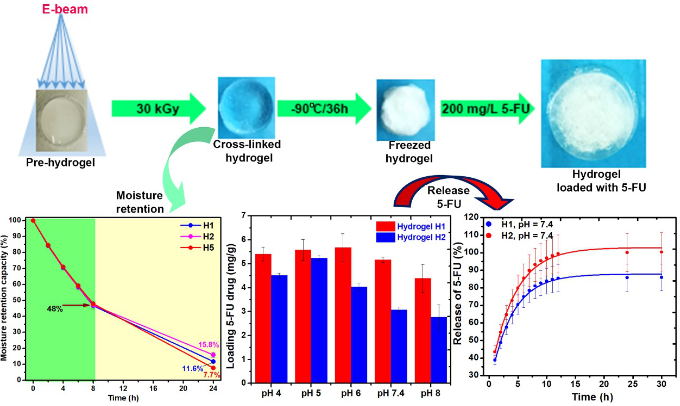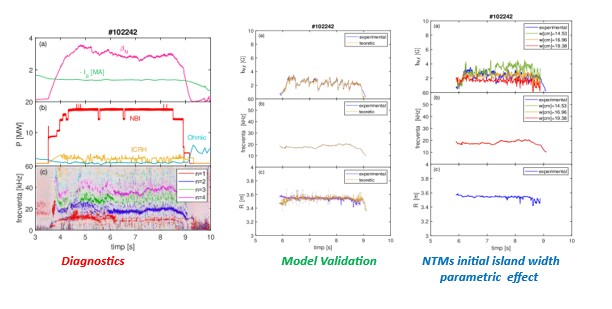
Schema de realizare a proiectului 23 03 01 - Anul 2025 - Etapa I
Contractul nr.: 30N/12.01.2023
Proiectul: "Dezvoltarea de solutii inovatoare si tehnologii de fabricație avansată cu laseri, plasmă și radiații pentru rezolvarea problemelor societale"
Faza 13/2025: "Studii experimentale și analitice pentru dezvoltarea de pansamente de tip hidrogel încărcate cu medicamente chimioterapeutice"
Responsabil fază: Dr. Maria DEMETER, Dr. Angela STAICU
Termen de încheiere a fazei: 09.04.2025
Abstract:
Multifunctional drug delivery systems are a new strategy in targeted cancer treatment, as they offer the advantage of delivering chemotherapeutic without affecting healthy cells and tissues. In this study, new polymeric compositions obtained from poly(vinylpyrrolidone), carboxymethylcellulose, poly(ethylene glycol), agar, and gellan gum were produced and characterized to develop hydrogel dressings loaded with chemotherapeutic drugs. The hydrogels were simultaneously synthesized (cross-linked) and sterilized by electron beam irradiation at a dose of 30 kGy. The functionality of the hydrogels was achieved through: sol-gel analysis, efficiency of the crosslinking process, swelling properties in simulated physiological and tumor environments, moisture retention capacity, structural analysis (ATR-FTIR), rheological properties, in vitro biodegradation, anticancer 5-FU drug loading capacity, and in vitro release profile of 5-FU. The release kinetics of 5-FU were investigated using mathematical models commonly employed in the design of pharmaceutical formulations. After irradiation, the hydrogels have a gel fraction of over 90%, and the crosslinking process predominates. The increased values of radiochemical yields of crosslinking (330 µmol/J), 16 times higher compared to those of degradation (20 µmol/J), confirm the formation of crosslinked hydrogels with a stable structure after irradiation. The swelling medium significantly influences the degree of swelling and the 5-FU loading capacity of the hydrogels. In a basic environment, the absorption capacity is 980-1090%, while in neutral pH it is significantly higher at 1380-1580%. Hydrogels retain approximately 48% moisture for 8 hours, which is sufficient to ensure the functionality of a hydrogel-type dressing. Rheological analysis showed that the hydrogels exhibit predominantly elastic behavior characteristic of a cross-linked macromolecular network (G’ = 3,450-54,000 Pa). The optimal loading capacity with 5-FU varies depending on pH, loading time, hydrogel composition, and 5-FU concentration, at 200 mg/L of 5-FU is 30% at pH 6 and 29% at pH 5. The release of 5-FU is slow at pH 7.4, gradually reaching 80% or completely within 30 hours, depending on the hydrogel composition. The in vitro release kinetics of 5-FU correlate best with the Korsmeyer-Peppas, Peppas-Sahlin, and Makoid-Banakar kinetic models (R2 > 0.99) and demonstrate that the release of 5-FU is primarily governed by an accelerated mechanism, followed by a diffusion-controlled mechanism. The experimental results demonstrate that hydrogels obtained through irradiation support the loading and release of anticancer drugs and show potential for use as dressings for local cancer treatment.
Abstract grafic:
Contractul nr.: 30N/12.01.2023
Proiectul: "Dezvoltarea de solutii inovatoare si tehnologii de fabricație avansată cu laseri, plasmă și radiații pentru rezolvarea problemelor societale"
Faza 14/2025: "Validarea modelelor și metodelor de analiză pentru caracterizarea plasmei de fuziune în sistemele tokamak destinate producerii de energie"
Responsabil fază: Dr. Eduard GRIGORE, Dr. Gabriel MIRON
Termen de încheiere a fazei: 09.06.2025
Abstract:
The aim of this work is to acknowledge the way the initial width of the magnetic island associated to the neoclassical tearing modes (NTM) affects the derivation of the NTMs amplitude and frequency. The proposed theoretical model we use has to be previously tested and validated in order to obtain the best match between the modelled and experimental modes amplitude, frequency and location especially. Because of this, a new method for the localization of the perturbations based of the knowledge of its amplitude is briefly presented. Relying on the successful testing of the perturbations model (Miron I.G. and JET Contributors 2021, Nucl. Fusion 61, 106016) against the experimental results at JET, its reversed implementation is applied in order to derive the location of the modes. The experimental mode amplitude plays, this time, the role of the input data with the aim to conversely obtain the perturbations location. The calculated location accuracy is conditioned by a good theoretical retrieval of the experimental mode amplitude and frequency. Based on the chosen initial conditions, the desired location is the one associated to the best possible mentioned retrieval. Our model reliability basically ensures the derivation of the suitable location. No safety factor and plasma rotational velocity data profiles are used. The method has been extensively tested and checked in order to become a valid alternative to the usual localization techniques.
Abstract grafic:


